#botanical witchcraft
Text
Rest
It occurs to me that once the punches slow, maybe it’s time to catch my breath and to write again. I haven’t updated in forever. I forgot I had something to say. I forgot what I had to offer. That’s how it goes isn’t it? We forget who we are and our deities bring us back to our own heart time and time again — if I let them. (And I don’t always let them)
I may give an overview of what’s happened since I’ve not been updating, but right now I feel it’s so important to talk about rest. It’s winter here and in NE Ohio, that means dreary weather, no sun which means drastic drops in vitamin D, seasonal depression, grey skies during the day, and early night and late morning. I’m eager for spring, but it also occurs to me that maybe I’m not ready for spring.
Since Christmas Eve, there has been one breakthrough after another after another after another. I’m exhausted. Even healing is hard work. At the time, I was high on the spiritual experience. I was high on prayer and companionship with Spirit and my ka-tet. I knelt in prayer and wept and I stood and I felt better. Sometimes I would sit in the shower under the hot water and cry and pray. There was always an answer, and usually one I didn’t expect or one that caught me by surprise. It was the great purge, cleansing and packing the wound so it could heal and the healing has been coming in waves. And now, I’m tired.
The thing about any high, spiritual or otherwise, is that we have to come down eventually. I keep my head in the clouds, but it’s time for my feet to return to the ground. The last month may have revolutionized my heart and mind and spirit, but I still have to cook dinner, and go to work and doctor’s appointments, and pick my daughter up from school, and all of everyday life.
For the last week or so, I’ve felt like I’ve been doing something wrong. I didn’t feel the 24/7 spiritual connection, my prayer has been falling away, I don’t feel like I’m being propelled forward by some unseen hand. The answers aren’t strong and punchy and life-altering. They’re quiet now if they come, like whispers instead of screams. Well I assumed that was because I wasn’t listening hard enough. I was distracted. I wasn’t praying enough or praying wrong. What happened? Where did God go? Where did my deities go? What did I do wrong and how do I get it back? Sound familiar?
I was laying down wrapped up tight in a blanket the other day just paying attention to my breathing and thinking of the morning I had spent with my friend. We had tea and breakfast together and then prayed and meditated together and it was wonderful, the recalibration that I needed, but it still wasn’t *the same.* I hadn’t had any earth-shattering realizations, hadn’t cried in a while. I felt that my healing had stalled — then I realized… this was my chance to breathe. I had been begging the Universe for weeks to slow down and give me a chance to catch my breath and I’m usually given what I ask for. The problem is I don’t always recognize, acknowledge, or accept when it comes.
So perhaps I don’t need to pray in such a prescribed and structured way multiple times a day at set times, pouring my heart out with my face pressed to the ground right now. Maybe it’s enough for now to keep Spirit on my mind and say a prayer of thanks and ask for direction. Right now I don’t need to figure out who and what I am on this side of all this healing. I don’t need to plan my life, define my vision, implement strict spiritual routines, and generally be ON all the time. I asked for a chance to catch my breath, and here it is.
So I’m going with it, or doing my best. Rest takes practice just like anything else, especially in this American capitalist dystopian nightmare where we’re brainwashed into believing that we’re only of value when producing. Anything else is a waste of time, we’re taught. I’m a rebel though, so I take naps. I take bubble baths. I read for pleasure. I cuddle my wife and friends and just exist. Rest is a rebellious action, and somehow knowing that makes it a little easier to justify to my brain.
I haven’t given anything up. I’m still studying and praying and doing magic and lighting candles and all, but I’m doing it in such a more gentle way. Instead of trying to work myself into a perscribed structure, I let the patterns work themselves out around me. They’re still forming and falling into place. Some will stick and some won’t and that’s ok. I don’t need all of that to be “spiritually successful” whatever the fuck that means. If my deities and my God have not left me these last 33 years, they’re not going to leave me if I take a nap after work instead of praying.
I’m telling you, listening to your body is rebellious. If I’m tired, I sleep, so much as I am able. When I’m hungry, I eat. When I feel a little lost, I pray. When I need comfort, I ask for it. I make time to play. And I have faith. I have faith that my deities don’t have to be in my face in order to be present. I have faith that if I reach out to them at any time, that they will still be there. They aren’t going to leave me. In fact, at a time when I didn’t have to capacity to commit to my deities, Loki and Sigyn committed to me. Sigyn told me shortly after starting to work with them that there was no place I could go, no distance that I could run that they wouldn’t find me and bring me home. I needed that then, so so much, and I need it now in a different way. It gives me permission to take a break and just breathe.
I may drift a little off course, but I’m not going to fall off the edge of the world, back into the darkness and emptiness. I’m just — I’m floating. That’s what I’m doing. Ok let me explain that. My family camps at a nearby lake over the summer and we do a ton of swimming. There’s a bunch of little cousins splashing around in the water, some of the older cousins on the boat deck grilling and drinking beer, or sitting in the water gossiping. Now, I do love to swim, but I don’t breath well and I get tired easily. My *favorite* thing to do is to swim out a little ways from the group and lay on my back with my eyes closed and float on top of the water. Sometimes a small wave will wash over my face and I’ll sputter and stand up, but I wipe my face and go back to floating. On occasion, I have to come up to make sure I’m not drifting too far from the group, or far enough out that I can’t safely swim back. But I just love the peace of hearing the water and the birds and the laughter and feeling the sun over my body while I float on top of the water.
So that’s what I’m going to do. I’m going to take a break from the deep diving that wears me out so much and I’m going to take advantage of the dark, sleepy, dreary time and the snow and cold that drives us inside, and this time when nature is resting and waiting for green and sun again, and I’m going to float and rest and breathe and have faith that my deities will hold me in that safe place.
🙏🏻
Here is a poem I wrote in the shower last night
Prayer
This poem is a thank you.
Thank you, Spirit, for turning me upside down.
It’s easier to write about love now
than it is to write about fear,
easier to write about mending hearts
than old scars.
Everything I once held near
seems so far removed now,
flung out into the depths of the cosmos,
beyond the stars I still cannot dream of reaching for,
farther than the east is from the west.
It will never be fully gone,
but it doesn’t gut me
every time I take a step forward anymore.
Still, I forget to pause and thank you.
See, I’ve always loved circles.
I love how they have no beginning and no ending,
no corners to try to peer around in the dark,
no jagged edges to make me bleed.
Everything is laid out bare, right in front of me
over, and over, and over,
and over, and over,
and over again, so it’s no wonder
how I got trapped in them for 33 years.
I’m still running in some of those same old circles,
afraid to cut ties, because if I cut too many of my heartstrings
I may just unravel again
and I’m tired of surviving my own heartbreak.
I don’t know who I am anymore,
but I know this freedom is well worth
the uncertainty of identity.
Thank you for turning me inside out,
that is to say everything inside me
that I kept tucked away
is now on display for the world —
my face, my song, my stance, my poise,
my bright eyes and covered hair,
an open hand pouring out.
Everything that once shielded me
has been brought back inside for healing.
These brick walls have been disassembled.
I’m using the old stone to build bridges and platforms now.
This poem is the closest thing I have to a prayer, so thank you.
Thank you for holding my hands
while my beloved and I searched for the right words.
In church as a child,
they taught me to talk to God
like he was my best friend,
but I don’t know how when my best friend is a stranger
wearing 7.8 billion of their favorite masks
as we all fumble along to their music in the firelight.
This poem is the closest thing I have to a prayer,
so please, take it and take *me*.
I don’t know who or what I am anymore.
I’m okay with that most days,
but it means that I don’t know what to offer you
because I don’t know what I’m made of.
This is the closest thing I have to a prayer.
I know it’s really just a poem,
but at least we got a couple of the letters right.
So take it, and take me.
Wherever you’re going, I will follow.
#paganism#deity work#nature#mental health#mentalheathawareness#restoration#trauma healing#norse heathenry#green witch#botanical witchcraft#celtic paganism#botanical magic#pharmakeia#tea magic#herbal witchcraft#prayer#meditation#shadow work#late stage capitalism#things loki taught me#loki deity#loki vibes#sigyn deity#norse sigyn
12 notes
·
View notes
Text
Any other botanical illustration nerds here?

Botanical illustrations have become one of my special interests over the past couple of years (starting with finding illustrations for the edition of Culpeper's Herbal I'm working on), and I've spent hundreds of hours sourcing, collecting, and restoring some gorgeous antique botanical illustrations.
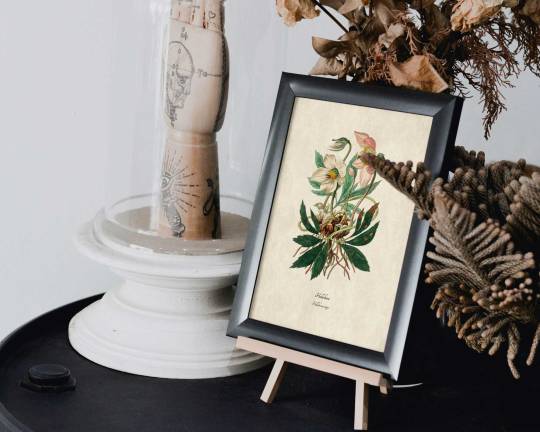
Well, I recently put together 100 of my favourites into a PDF with an antique paper texture, all labelled with their common and scientific/Latin names, and it's made me wonder... if it's worth my selling the (digital) copies of illustrations I've lovingly restored? 🤔

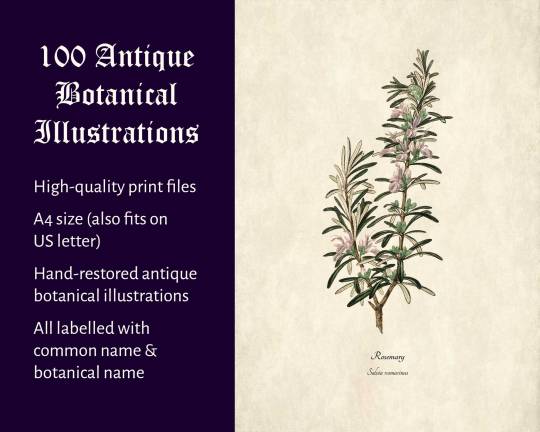
This is the collection of 100 antique botanical illustrations I've recently published on my website, but the illustrations are sourced from a whole list of publications full of absolutely stunning botanical artwork, and it's making me wonder if this is something other people would be interested in?


Aside from sourcing, collecting/collating, and restoring the images, I've also labelled each and every file with their current botanical name, making them easy to navigate for images for you grimoire, book of shadows, materia medica, or other plant-based journal 🥰

#witchynyx#witchcraft#green witch#botanical illustrations#botanical#botanical artwork#druidry#original content#herbalism#grimoire#materia medica
19 notes
·
View notes
Text

Satyr Sculpture By Frank Lynch (1924) 🍇🤘🖤
Royal Botanic Gardens in Sydney, Australia 🇦🇺🌿🌸
Picture taken on April 24, 2016 📸✨
Wikimedia Commons
#satyr sculpture#satyr#Frank Lynch#royal botanic gardens#sydney#australia#dark pagan#dark paganism#demonolatry#theistic satanism#satanic witch#witchblr#witchcraft#paganblr#spiritual satanism#left hand path#occult#faery faith#demons#dark art#sculpture#pagan#paganism
90 notes
·
View notes
Text
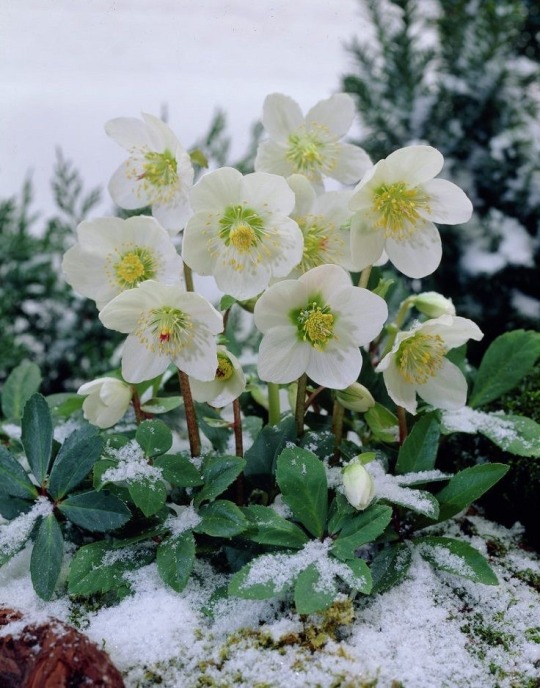
Christmas Botanicals Series: Black Hellebore
Next up in the christmas botanicals series is the christmas rose, also known as black hellebore. Hellebore is a flowering perennial with evergreen leaves in the famously poisonous Ranunculaceae family which also contains aconites (wolfsbane), delphiniums, meadow rues, clematis species, and ranunculus (ranging from wild buttercups to ornamental flowers).
Hellebore contains saponins, cardiac glycosides, and other toxins. While ingestion of hellebore may not be deadly to humans, it is incredibly unpleasant. Symptoms include contact dermatitis, burning skin, burning of the mouth and throat, stomach pain, nausea, vomiting, diarrhea, dizziness, confusion, and irregular heartbeat.
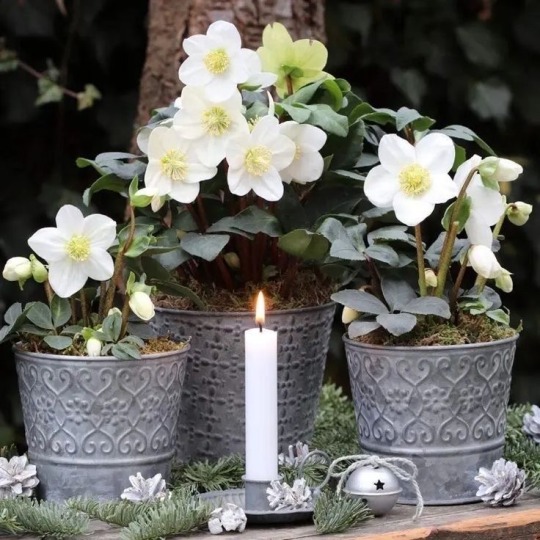
Hellebore was one of the first documented chemical weapons used in warfare. The Greeks used the potently poisonous leaves to taint the entire water supply of the sacred city of Kirrha in 585 BCE to end a 10-year siege. It did not kill the residents but incapacitated them with vomiting and diarrhea while the Greek army invaded and slaughtered the entire population by the sword.
Hellebore has been venerated as a powerful plant by multiple ancient civilizations and was included in medical texts by the likes of Hippocrates and Theophrastus.
Black hellebore eventually became associated with christmas due to its evergreen leaves and naturally blooming in winter near the older date of christmas from the Julian calendar. Like mistletoe, the association is likely older than christianity and it was also brought in the home during the dark of winter to protect from evil spirits, ghosts, witches, and illness, but unlike mistletoe hanging in the roof rafters, hellebore was supposedly strewn on the ground with the rushes. Like hanging mistletoe, people in the British Isles and Europe continued the protective practice after converting to the new religion. Today the practice has changed to decorating with hellebore flowers for christmas.
#bane folk#poisonous plants#poison path#hellebore#black hellebore#helleborus niger#helleborus#christmas botanicals#christmas plants#christmas rose#plant folklore#ethnobotany#magical plants#magical herbs#green witchcraft#green witchery
29 notes
·
View notes
Text
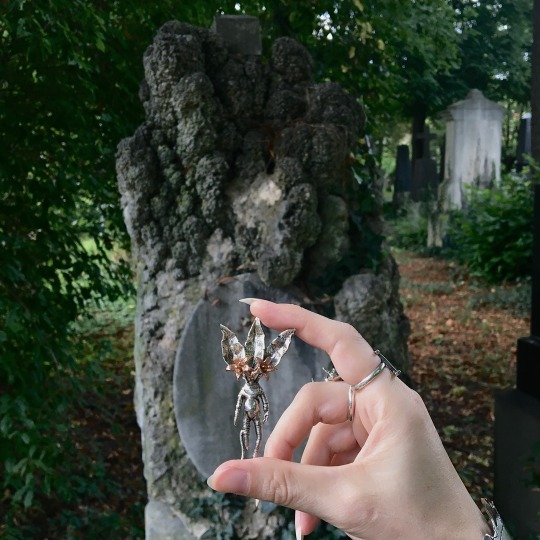
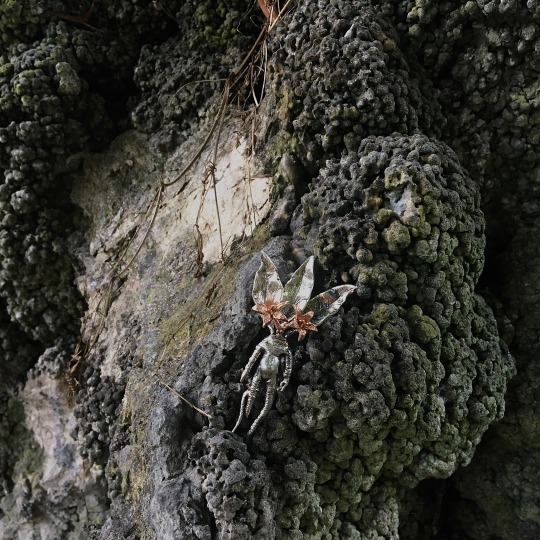
Mandragora, silver mandrake jewelry ("with flowers" version) hand carved by Moon and Serpent Website or Etsy
For more, please follow my Tumblr or Instagram
#moon and serpent#artists on tumblr#handmade jewelry#botanical jewelry#witch jewelry#poisonous plants#mandrake root#mandragora#poisonous#poison path#poisonous flowers#witchcraft#witch aesthetic#gothic aesthetic#paganism#fantasy art#faerie
84 notes
·
View notes
Text

Fave 🖤
#nicole kidman#sandra bullock#practical magic#witch#witchcraft#movies#90s#botany#botanical#cinephile#collage#autumn#fall vibes#comfort#comfort movies
27 notes
·
View notes
Text






#aesthetic#aromatherapy#aromantism#aromantic#lavender#aromaterapia#aesthetic moodboard#witchcraft#cottagecore#moodboard#green witch#botanical#botanic garden
14 notes
·
View notes
Text
"You better not be a sexy hallucinogenic root when I get there..."
My mandrake ass:

Day 26 of Weird Medieval October ;)
Acrylics on paper, 3x4"
#weird medieval october#weird medieval guys#medieval art#mandrake root#vegetables#plant art#botanical art#mystical#witchcraft#middle ages#artists on tumblr#art#painting#pop surrealism#agblend13#traditional art#acrylic painting#lowbrow art#traditional painting#surrealism#funny art
27 notes
·
View notes
Text
Everything You Need to Know About Herbs: Garlic
Garlic (Allium sativum)
*Kitchen Herb *Medical Herb *Feminine

Folks Names: Ajo, Poor Man’s Treacle, Stinkweed, Stinking Rose
Planet: Mars
Element: Fire, Earth
Deities: Hecate
Abilities: Protection, Healing, Exorcism, Lust, Anti-Theft, Aphrodisiac, Banishment, Purification, Clarity
Characteristics: A bulbous perennial plant that can grow to from 1- 3 ft tall. Has pale pink or green white flowers. Is part of the lily family and native from Central Asia. It is grown by dividing the bulbs and is harvested during the late summer.
History: It was first noted by Confucius in the Book of Odes. However, the lore refers garlic back to the beginning of time. It is said that when the devil’s left foot touched soil outside the Garden of Eden, garlic sprung up and his right foot produced onions. This caused it to be first associated with the Devil himself but the Greeks considered it a protector herb later on. Greek midwives would make sure that at the birth of a child, the whole room smelled of the cloves to protect the newborns from Lilith, the mother of all demons. If the cloves were not placed around the neck of the babies, it was believed that Lilith would strange the babies and frighten the mothers into madness. It was also a great remedy herb as every part of it was used in over 125 different treatments.
How to Grow Garlic
Easy to Grow: Yes
Rating : Beginner Friendly
Seeds Accessible: Yes but growing from bulbs is easier
How to Grow Garlic
Video Guide
Seeds
Magical Properties:
Was worn to guard against the plague
Sailors carried some on board to protect from wreckage
Soldiers wore garlic as a defense and ate it for courage
Worm to guard off foul weather and monsters
Bite into garlic to send away evil spirits or sprinkle garlic powder on the floor
Garlic was eaten on festival days to Hecate and was left at crossroads as a sacrifice to her
Brides carried garlic in their pockets for good luck
Rubbed onto pots and cooking pans, can remove negative vibrations
Can induce lust and attract lovers
Burned in an incense can be used to exorcise evil spirits from one’s home
Can strengthen energy fields and break curses
Medical Usage:
Can combat high cholesterol and hypertension
Was believed to ward off cancer and hepatitis
Can boost your immune system and is a powerful antibiotic for any sickness
Helps to keep blood thin and protect against blood clots and raised blood-sugar levels
Was used to dress wounds in WW1
A remedy for chest infections, digestive infections, and prevent circulatory problems
Sources
#witchblr#witch community#witchcraft#green witch#occulltism#paganblr#plants and herbs#nature#herbalist#medicinal herbs#culinary#herbalism#herbs#culinary herbs#kitchen witch#witch blog#botany#botanical#witch garden#witchcraft 101#witchcraft resources#witches of tumblr#baby witch#beginner witch#pagan witch#garlic#hecate
45 notes
·
View notes
Photo

~* Strawberry Fields *~ Went strawberry picking for the first time. It was amazing to see how they grew.
#strawberry#strawberry fields#strawberry picking#cottage#cottagecore#nature#farm#litha#midsummer#summer solstice#green witch#green witchcraft#witchblr#botanical#botany
51 notes
·
View notes
Text
I have a friend coming down to the lake today who has agreed to let me experiment on them with tea blend flavors. I wanted to try out fennel, a flavor profile outside my comfort zone. So this morning I brewed a couple herbs to test out fennel in a blend. The blend was just fennel and rosemary for flavor, and my ever-present blue butterfly pea for color. It was so good. I didn’t crush the fennel seeds this time, so the flavor was present, but not overwhelming. The rosemary paired perfectly with it. This really motivates me to try other licorice-esque flavor profiles. I’m really excited to see how my friend likes it.
Fennel
From The Herbal Alchemist’s Handbook by Karen Harrison:
Scientific name: foeniculum vulgare
Other name: fenkel
Element: Water
Planets: Mercury, Moon
Parts used: seed, leaf, essential oil
“Like white Sandalwood, fennel enjoys the dual ruleership of Mercury and the Moon. It aids in obtaining psychic impressions (Moon) and interpreting those impressions accurately (Mercury). Fennel is also used in protection rites – strew the whole seeds in each room, burn in an Incense blend, or make an Infusion with the seeds and wash the walls and floor. Burning fennel in Incense or anointing the Third Eye also clears the mind and aids in memory. Fennel seeds are tossed at a wedding couple like rice for health and abundance in the relationship.”
From Entering Hekate’s Garden by Cyndi Brannon (repeat information omitted)
Genius: foeniculum
Classification: Vegetable
Spiritual properties: Communication, courage, healing of the mind, sexuality
Physiological properties: armomative, digestive, pesticide
Magickal properties: breaking curses and bad luck, clarity, communication, courage, dealing with authority and govt, prevention, psychic witchcraft, visions
Elemental correspondences: Air [note that the previous entry listed water]
Archetype: Rixipyle (Breaker of Chains)
World: Upper
Zodiac: Aquarius, Gemini
Color: blue
Stone: blue agate
Animal: magpie
Indications: Generally safe in small doses, but not for use during pregnancy. Take caution with children and pets.
**Select Notes**
“ An ancient member of Hekate‘s garden, this licorice-flavored plant was consumed for courage, protection, and strength, and for victory in competitions by the ancients. Fennel is a breaker of chains meaning that it has the power to remove blockages, especially for all forms of communication.
“Fennel is sometimes used in love philters, to encourage sending off the right signals regarding romance and sex, giving it a reputation as a sexual stimulant. It’s applications extend to all manner of communication problems, from breaking curses to removing barriers for successful engagement with authority figures and government, rendering it in apothecary necessity.”
Formulations:
* The seeds are very easy to work with. Release their properties by lightly grinding them in a mortar with a pestal. To enhance communication, grind clockwise; to remove barriers, reverse the direction.
* Five is the number most associated with fennel. Release its property by using multiples of five when grinding and use seeds and multiples of the same number.
* Fennel is excellent as part of a tonic, although continued daily use beyond six weeks is not recommended. To make a tonic, add 1/2 tsp to a cup of boiled water. Let the mixture steep for 15 minutes, as fennel is a bit slow to release. Use on its own or mix into your daily tonic.
* Carry fennel seeds in a glass vile. They’re excellent for digestion and for on-the-go witchery. Slip a few seeds in where needed. Chew the seeds to ease digestion and to speak the truth. Five will do the trick.
* Fennel is strongly associated with Mercury. Adding this planetary symbol to any working will increase its potency.
Pharmakeia:
“Fennel is a very specific botanical that is eager to help with a variety of situations involving breaking barriers to communication. It is excellent for breaking down resistance. Drink a tonic and watch your procrastination dissolve.
“Fennel at the threshold ensures that only the truth is spoken within. Add it to your home wards—those protective barriers placed at the entrances or around the perimeter…”
Rosemary
From The Herbal Alchemist’s Handbook by Karen Harrison:
Scientific name: Rosemarinus officinalis
Other name: elf leaf
Element: Air
Planet: sun
Parts used: leaf, essential oil
“ The reviving scent of rosemary stimulates the memory and thought process. Its scent when burned or added to any herbal preparation adds an energy of protection and purification to a space. The oil applied directly to rashes and skin blemishes clears the area, and when inhaled, its aroma aides the memory and brain functions. Sprinkling rosemary leaves over a grave brings comfort to the dead and memories for the ones left behind. Rosemary placed in the bath before bedtime wards away nightmares, and when carried in an Herbal Amulet, it gives confidence and courage.”
From Entering Hekate’s Garden by Cyndi Brannon (repeat information omitted)
Genus: salvia rosmarinus, formerly rosemerinus officinalis
Classification: herb
Spiritual properties: Cleansing of the spirit, contentment, invigoration, recollection, restoration
Physiological properties: rub sore muscles and joints with rosemary oil, rub on temples to ease headache, drink a tonic to improve sleep and ease nightmares. Since it is so beneficial, it makes an excellent ingredient in a daily infusion. Balances the menstrual cycle and eases symptoms.
Magickal properties: awareness, banishing, cleansing, comfort, confidence, contentment, focus, loving spirits, memories, renewal, youth
Part used: leaves
Planetary correspondences: Sun
Elemental correspondences: Fire [note: previous entry indicated air]
Archetype: Ergatis (Energizer)
World: Middle
Zodiac: Virgo
Color: Pink
Stone: pink quartz
Animal: toad
Indications: generally safe for all. Large quantities may cause stomach upset.
**Select Notes**
“Rosemary is a kitchen herb with potent magical properties. It was used by Hekate‘s ancient whitches to ward off evil, improve memory, and for invigoration. The traditional lore is that, where Rosemary grows, the woman of the home will be in charge and well. It is not surprising that some husbands ripped the plant from the ground to prevent this from happening. Nowadays, we women can rule the home as much as witches with Rosemary as one of our familiar spirits.
“Rosemary is strongly associated with the sea, given its natural habitat along the shores of the Mediterranean, making this a suitable offering to Hekate Einalia, in her role as a goddess of the sea. Rosemary brings clarity to emotions, tempering the saltiness and depths of the deep blue. It is a warming plant that restores our inner fire without causing an inferno. It is suitable for loving remembrance of the departed, but note that Rosemary is not a botanical used alone for summoning the departed or spirits. Add Sage and Mugwart to a bundle for these workings.”
Formulations:
* Rosemary is an essential in a witch’s apothecary, for it stands alone as the supreme bringer of loving purification and protection. It’s like Hekate’s arms, enveloping you in fierce love.
* oils, tinctures, infusions, and waters can all be made with rosemary.
* Rosemary poultices placed on a sad heart will help it mend.
Pharmakeia:
“ To ensure an untroubled home, free of stress and conducive to health for the occupants, grow rosemary by your main entrance. It’s one of my ultimate witch tips. Rosemary grows well without our involvement. Make sure the plant is big enough to be comfortable. Since this proud member of Hekate’s garden is so hearty, my Rosemary is a bellweather for our home. If the plant shows signs of distress, I investigate to see who isn’t doing well or if there’s a problem with the house or land. A bath infused with rosemary lets you soak in protection and contentment.”
 Both of these books are fantastic and indispensable references in my witchy library. Entering Hekate’s garden provides workings with each plant entry. My notes have been truncated to allow for space. I highly suggest investigating both books on your own.


#green witch#green witchcraft#paganism#witchblr#botanical magic#botanical witchcraft#herbal magick#witches#pharmakeia#hekate#hecate#hellenic polytheism#hellenic deities#hellenic devotion#spell work#herbal witchcraft#witchcraft spells#plant spirit witchcraft#plant spirits#tea magic#herbalwitch#herbalism#herbalmedicine#herbalblends
42 notes
·
View notes
Text
Blackthorn Pendant (Real Sloe Thorn & Sterling Silver)





This devotional pendant was ritually crafted from real Blackthorn and solid Sterling Silver, in order to showcase the natural majesty of Blackthorn spines. It was likewise hallowed and ensouled by the tutelary spirit of the Sloe Tree in a ceremony that involved the piece being fumigated with a smoke of Dragon's Blood and Blackthorn Blossoms.
Blackthorn is a tree with many centuries of folklore pertaining to it, and much of that lore has to do with witchcraft and the occult. Its uses and associations go back for millennia, often in connection with the witchcraft, and maleficia, in particular. As such, its spirit is a powerful ally in all works of Maleficent or otherwise Offensive magic, though it also bears strong associations with Winter, Protection, and even the Fae.
Each piece comes with an 18" Sterling Silver box chain and a velvet storage pouch. If you are interested in acquiring one of these pendants, either reach out to me through tumblr or purchase it directly from my shop, Wending Wares.
18 notes
·
View notes
Photo

❤️Happy Venus Day Love Witches❤️🦢🌹Friday is sacred to Venus, the Goddess of Love, pleasure, sensuality and beauty. It is a day to indulge in self care, self love and all things love 💕 Venus' charming energy makes it the perfect day to get creative, or even go on a first date with your crush. Friday is also ideal to indulge in self-love 🌹treat yourself with some fresh flowers (sacred to Venus/Aphrodite), enjoy a sensual and relaxing bath, wear your favourite lingerie, work with heart chakra crystals like kunzite, rose quartz, rhodochrosite, pink opal, malachite, order take out, drink wine, take the day off or cast yourself a self love ritual. How are you celebrating Venus Day? 💖🌹 • • • #unicornmanor #magick #aphrodite #venus #goddess #venusday #selflove #selfcare #rosequartz #witch #witchcraft #witchesofinstagram #witchyvibes #witchythings #blessings #gratitude #flower #flowermagic #botanicals #sacred #sacredspace #witchery #witchlife #witchaesthetic #witchesofaustralia #witchtok #crystal #crystals #crystalhealing #lovewitch https://www.instagram.com/p/CpljoD9ym0S/?igshid=NGJjMDIxMWI=
#unicornmanor#magick#aphrodite#venus#goddess#venusday#selflove#selfcare#rosequartz#witch#witchcraft#witchesofinstagram#witchyvibes#witchythings#blessings#gratitude#flower#flowermagic#botanicals#sacred#sacredspace#witchery#witchlife#witchaesthetic#witchesofaustralia#witchtok#crystal#crystals#crystalhealing#lovewitch
38 notes
·
View notes
Text

Just added to the shop. I’ve only got a few of these left so grab one if you were waiting for me to get them on the site. ♥️
4 notes
·
View notes
Text
Lavender
lavendula officianle
lavendula angustifolia
Perennial flower
Most active parts in it: geranial, cinede, courorin.
Planet: mercury
Element: Air, water
gender: masc
Associations
Peace
Relaxation
Sleep
Purification
Loyalty
Grounding
Love/romance
Healing
Happiness
Psychic abilities
Said to be a good herb to start with when teaching children
-----------------
medicinal
Antioxidant
Anti-inflammatory
Anti-septic
Antibacterial
Disinfectant
Antibodic
Anti allergic
Anxiety
Asthma
Boils
Bruises
Dandruff
Nausea
Nightmares
Insomnia
Lice
Migraines
Insect repellent
Stress
Stretch marks
Sun burns (first degree)
Whooping cough
Wounds
Digestive problems
Acne
Hypertension
Etc
not all lavender has anti septic activity
do not use in place of medical professional opinion
You can use this herb essential oil in; diffusers, diluted for massages, compression, shower/bathes.
Lavender foot soaking:
Warm water, 4 drops of Lavender essential oil or Lavender bath salts
Soak for however long you feel.
Good for opening your blood vessels.
Facial oil:
3 drops Lavender oil, 1 quart distilled water
Dab on your face daily.
use this info at your own discretion
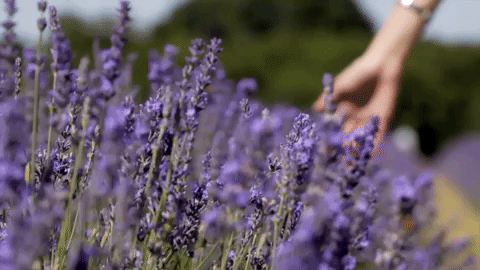
#beginner witch#witch tips#witchcraft#herbalism#herbs#herbal#essential oils#lavender#botany#botanical#baby witch#cottagecore#light academia#witchblr#witch community#plant community#plants#plantblr#witchythings#witchcraft community#witchcraft info#herbal information#herbalist#spirit work#spirituality#holistichealth#self love#self care#naturecore#fairycore
14 notes
·
View notes
Text
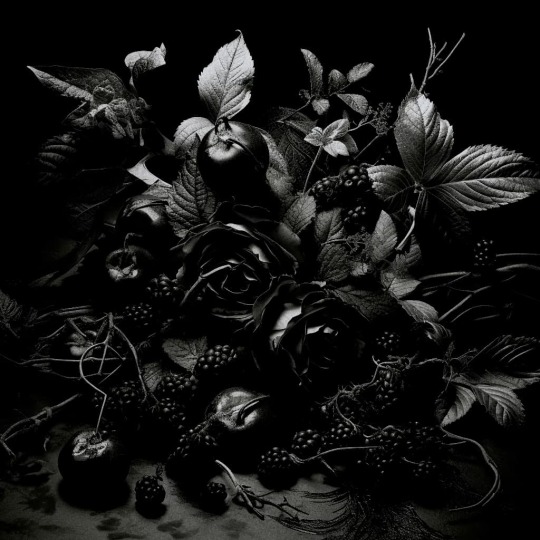
ℐ𝓃𝓉𝓇𝑜𝒹𝓊𝒸𝓉𝒾𝑜𝓃 𝒯𝑜 𝒮𝒽𝒶𝒹𝑜𝓌 𝒲𝒾𝓉𝒸𝒽𝒸𝓇𝒶𝒻𝓉 ℬ𝑜𝓉𝒶𝓃𝒾𝒸𝓈
A Gᴜɪᴅᴇ Tᴏ Usᴇғᴜʟʟ Hᴇʀʙs ﹠ Fʟᴏᴡᴇʀs.
Shadow witchcraft, like many other forms of witchcraft and magical traditions, incorporates a deep reverence for the natural world and the power of herbs in its practices. Within the shadow witchcraft tradition, certain herbs are considered sacred and hold a special place in rituals, spellwork, and healing. These herbs are chosen for their unique properties, both physical and metaphysical, and are often used to enhance the practitioner's connection to the shadows, the spirit world, and the unseen forces that permeate our reality.
Mugwort (Artemisia vulgaris): One of the most iconic herbs in shadow witchcraft, mugwort is revered for its ability to enhance psychic abilities and facilitate astral projection. It is believed to provide clarity in dreams and aid in connecting with the spirit world.
Belladonna (Atropa belladonna): Belladonna is a potent and highly toxic herb often associated with the darker aspects of shadow witchcraft. It is used cautiously, as it can induce altered states of consciousness and enhance divination, but it must be used with extreme care due to its deadly nature.
Mandrake (Mandragora officinarum): Mandrake is a legendary herb that holds a prominent place in shadow witchcraft due to its associations with powerful magic and the ability to summon spirits. It is considered a protector of the practitioner.
Wormwood (Artemisia absinthium): Wormwood is an herb that has been traditionally used in shadow witchcraft for its protective properties, as well as its association with absinthe, a spirit that has inspired many artists and writers.
Datura (Datura stramonium): Datura, also known as "thorn apple," is another highly potent and toxic herb. It is associated with shamanic journeying, but extreme caution is necessary when working with it due to its dangerous properties.
Henbane (Hyoscyamus niger): Henbane is used in shadow witchcraft for its ability to induce trance states and facilitate communication with spirits. Like belladonna and datura, it is a toxic plant and must be used with care.
Wolfsbane (Aconitum napellus): Wolfsbane, also known as aconite, is associated with protection and transformation in shadow witchcraft. It is believed to ward off malevolent entities and is used in rituals that involve shape-shifting.
Nightshade (Solanaceae spp.): Nightshades encompass various plants, including belladonna, datura, and mandrake, all of which have their unique uses in shadow witchcraft. They are linked to altered states of consciousness and spirit communication.
Hemlock (Conium maculatum): Hemlock, another toxic plant, is associated with necromancy and the summoning of spirits. It is used with extreme caution in rituals and spellwork.
Yew (Taxus baccata): Yew is considered sacred in shadow witchcraft due to its association with death and rebirth. It is often used to honor ancestors and connect with the spirit world.
Blackthorn (Prunus spinosa): Blackthorn is a protective and banishing herb, often used in warding off negative energies and spirits. Its thorny branches are seen as a natural barrier against harm.
Alder (Alnus spp.): Alder is linked to the element of water and the power of psychic intuition. It is used in divination and to enhance the flow of energy during rituals.
Rowan (Sorbus aucuparia): Rowan, also known as mountain ash, is considered a powerful protective herb in shadow witchcraft. It is used to ward off malevolent spirits and energies.
Nettle (Urtica dioica): Nettle is used for purification and removing curses. Its sting is seen as a symbol of protection, and it is used in banishing rituals.
Willow (Salix spp.): Willow is associated with the moon and feminine energy, making it a significant herb in shadow witchcraft. It is used for divination and connecting with the cycles of the moon.
Oak (Quercus spp.): The mighty oak is a symbol of strength and protection. In shadow witchcraft, it is used to connect with ancient wisdom and to invoke the energies of the earth.
Hawthorn (Crataegus spp.): Hawthorn is considered a portal to the fairy realm and is used for protection against malevolent spirits. It is also associated with love and passion spells.
Poppy (Papaver spp.): Poppy is used to induce altered states of consciousness and to facilitate dreamwork and divination. Its connection to Morpheus, the god of dreams, is significant in this context.
Broom (Cytisus scoparius): Broom, also known as Scotch broom, is associated with purification and is used to sweep away negative energies and influences.
Juniper (Juniperus communis): Juniper is used for purification and protection. Its fragrant berries are believed to ward off evil spirits and negative influences.
Cypress (Cupressus spp.): Cypress is associated with the afterlife and is used in rituals to communicate with the spirits of the deceased. It is also used for banishing and cleansing.
Hellebore (Helleborus spp.): Hellebore, sometimes called "Christmas rose," is believed to banish evil spirits and protect against their influence. It is also used for divination and dreamwork.
Horehound (Marrubium vulgare): Horehound is used for protection and exorcism. It is believed to repel negative energies and harmful spirits.
Vervain (Verbena officinalis): Vervain is considered a sacred herb that enhances magical abilities and protection. It is often used to purify and consecrate ritual tools.
Mullein (Verbascum thapsus): Mullein is associated with the element of fire and is used in shadow witchcraft for protection, especially against dark forces. Its tall, candle-like stalks are seen as beacons of light in the spiritual realm.
Baneberry (Actaea spp.): Baneberry is associated with the banishment of evil and negative influences. It is often used in protection spells and rituals.
Devil's Claw (Proboscidea spp.): Devil's claw is believed to possess the power to dispel malevolent spirits and curses. It is often used in rituals designed to break hexes.
Monkshood (Aconitum spp.): Monkshood, like wolfsbane, is associated with transformation and protection. It is used to enhance shapeshifting and to ward off harmful entities.
Oakmoss (Evernia prunastri): Oakmoss is associated with grounding and connecting to the energies of the earth. It is used to enhance the stability of shadow witchcraft rituals.
Witch Hazel (Hamamelis virginiana): Witch hazel is used for protection, divination, and healing. Its branches are seen as divining rods to connect with the spirit world.
Skullcap (Scutellaria spp.): Skullcap is associated with psychic protection and enhancing clairvoyance. It is used in rituals to open the third eye and connect with the unseen.
Yarrow (Achillea millefolium): Yarrow is used for divination and love spells in shadow witchcraft. It is believed to enhance the practitioner's intuitive abilities.
Vetiver (Chrysopogon zizanioides): Vetiver is used for grounding and connecting with the earth's energies. It is often used in spells to anchor and stabilize the practitioner's intent.
Dandelion (Taraxacum officinale): Dandelion is associated with transformation and communication with spirits. Its seeds are often used in divination rituals.
Black Cohosh (Actaea racemosa): Black cohosh is used in shadow witchcraft for protection, banishing, and dispelling negative energy. It is believed to have a purifying effect.
Cedar (Cedrus spp.): Cedar is used for purification, protection, and enhancing spiritual connections. It is often used in smudging and cleansing rituals.
In shadow witchcraft, these sacred herbs and botanicals play a crucial role in connecting with the hidden realms, communicating with spirits, and working with the shadows. Practitioners approach their use with a deep respect for the natural world and the mysteries of the unseen, drawing upon the wisdom of these plants to navigate the intricate tapestry of shadow magic. It is important to remember that many of these herbs are toxic and should be used with caution, if at all. Always prioritize safety and ethical considerations when incorporating these plants into your practice.
© Dʏsʜᴀɴᴋᴀ/Oᴅᴇᴛᴛᴇ ₂₀₂₃
#Herbs#Shadow Witchcraft Herbs Introduction#Shadow Herbs#herbology#Witchy Botanics#Witchcraft#witchcraft australia#Witchcraft Author#Witches of Australia#Shadow Witch#Articles#Article#Wordy Sunday#Sunday Writing#Gothic Witch#The Wisdom of Plants#Spiritual Medicine#Contemporary Witchcraft#Hereditary Witchcraft#Follow
14 notes
·
View notes